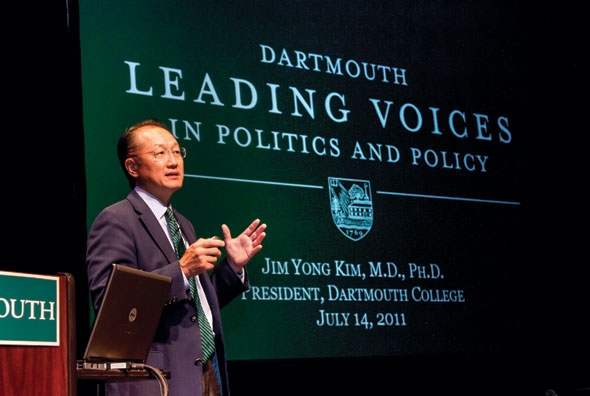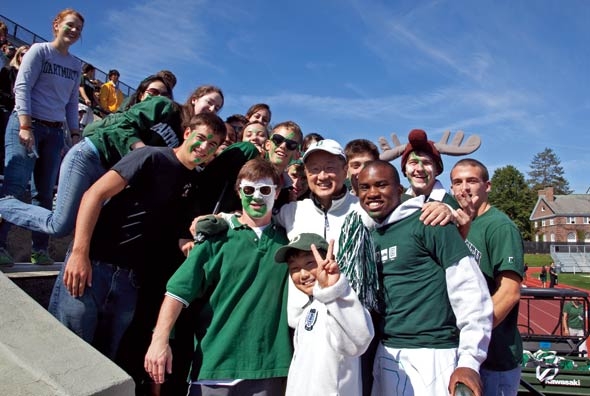Jim Yong Kim is making his way across the Green. He’s striding. Dartmouth’s 17th president doesn’t stroll or ramble. In a Dartmouth cap and green tie—always a green tie—he leans into the hill-wind.
Kim hit his stride early. In a scholarly analysis of Dartmouth’s DNA, the anthropologist-physician found the words that would define his presidency. It has been impossible to be on the Hanover Plain, indeed, to be anywhere Kim is speaking, and escape his call to action as he quotes the 1946 Convocation address of Dartmouth’s 12th president, John Sloan Dickey: “The world’s troubles are your troubles ... and there is nothing wrong with the world that better human beings cannot fix.”
In his three years at Dartmouth, Kim’s productive impatience drove results. In the face of a financial crisis, he led an overhaul of the way the College does business. He seeded an interdisciplinary partnership that created the new field of health care delivery science. And he attracted peers to a national collaborative to take on high-risk drinking.
And then—too early for some—he changed course.
In March, Kim seized an opportunity he didn’t seek, but one he couldn’t refuse. He will leave Dartmouth on June 30 to become president of the World Bank. This global health advocate who, before Dartmouth, spent his days among the world’s poorest people, was nominated by President Barack Obama to take the helm of the world’s most important development agency. It wasn’t that Obama called, it was that Obama called about this job.
‘Dartmouth’s Loss, the World’s Gain’
“This is obviously Dartmouth’s loss but the world’s gain,” says former Sen. Judd Gregg (R-N.H.), the father of three Dartmouth graduates. “Jim, even in his short time at Dartmouth, has had a strong and positive impact on the school and its culture. The energy and outcomes-focused approach that he has used so successfully at Dartmouth will certainly serve him well at the World Bank.”
What Kim set in motion will flourish. In the last three years, the College has increasingly turned its face to the world, while at the same time the community has rallied to take care of its house, its Dartmouth.

President Kim spoke about health care reform in the “Leading Voices in Politics and Public Policy” lecture series in July 2011. The series was inspired by President John Sloan Dickey’s popular Great Issues class, which was taught for two decades beginning in 1947. (photo by Joseph Mehling ’69)
“There has been a fire and an energy on this campus,” says Bob Hansen, senior associate dean at the Tuck School of Business. “Jim Kim had a way of inspiring and motivating people to get things done.”
Every president has left a legacy, says economics Professor Bruce Sacerdote ’90. “It’s always Dartmouth, regardless of which president we’ve had. They each pushed on different parts of our mission and tried to strengthen us in different ways,” he says. “Under Jim Kim, it’s obvious the place has gotten stronger.”
Pushing the Knowledge Base
Right from the start, Kim wanted to learn. He ate lunch with faculty members to soak up their research, their teaching methods. And he got many of them working together. New endeavors large and small have involved inaugural collaborations across disciplines, including in the health care delivery work and the ongoing strategic planning effort, say faculty leaders.

President Jim Yong Kim tours the lab of Associate Professor of Chemistry Jon Kull ’88 in July 2009. (photo by Joseph Mehling ’69)
Jim Kim: In His Words“He encouraged, pushed, and cajoled all of us to really think of this as a single academic institution. To build a structure where you can draw on expertise from different departments is immediately relevant,” says Joe Helble, dean of Thayer School of Engineering. “That’s a legacy that will live on.”The most important thing is that Dartmouth has to have really high aspirations. I hope that what I helped to do was to craft a vision, a powerfully aspirational vision, of what Dartmouth can be.
We’re unique in that we take pedagogy, scholarship, and engagement very seriously. So many institutions only take research seriously and the other two are afterthoughts. We have a chance to make them co-equal objectives that together build a strength of institution, the likes of which doesn’t exist in the world. It’s not my plan for Dartmouth, it’s in the DNA of this institution.
I’m proud that we acted quickly and effectively in tackling the budget deficit. We drove organizational change in a way that didn’t disrupt the culture.
We’ve taken on social life issues. We are making real progress on binge drinking and sexual assault and I’ve been more open and direct about it than any president in the country.
Health care delivery science is a way of bringing the resources of the institution to bear on the most important problems. We created a new field. That’s no small thing. I brought together elements that were already here—The Dartmouth Institute and the business school, the engineering school, and the medical school. This new field is going to explode over the next few years, and I think Dartmouth will continue to be at the forefront.
Athletics are on the rise. We’re going to continue to show the country and the world the importance of athletics and physical exercise in the development and well-being of young people—and old people. I think the medical evidence is overwhelming: Competitive athletics and physical activity are important for learning and emotional well-being.
I didn’t come to Dartmouth thinking that the World Bank was my next job. There’s not a lot that would have pulled me away. But I’m a person who’s spent most of his life trying to make things better for poor people. People like me have never been asked to do this kind of job before. My reasoning for taking the World Bank position is the same as my reasoning for taking the Dartmouth presidency. What can I do as a leader to tackle the world’s troubles and train the kind of better human beings who will change the world?
My affection for this place is deep and will persist. I hope people remember that. I really love Dartmouth alumni. They’re my kind of people. The love of Dartmouth binds people together in a wonderful way. I’m an over-the-top Dartmouth cheerleader. Green tie every day. It’s OK to do that. You wouldn’t do that at other Ivy League institutions. It fits here.
And Kim looked back as much as he projected forward, drawing inspiration from traditions such as President Dickey’s popular Great Issues course, taught for two decades beginning in 1947, to inform the new “Leading Voices in Politics and Policy” course and lecture series in the summer of 2011, and later the strategic planning lectures, “Leading Voices in Higher Education.”
“I still have students coming up to me and talking about last summer’s lectures,” says Sacerdote.
In another new collaboration, facilities managers are working with Thayer engineers to consider ways to reduce energy consumption and use alternative power sources.
“He’s asked us how Dartmouth can push the global knowledge base,” says Director of Sustainability Rosi Kerr ’97. “In the area of sustainability, that’s a pretty novel approach for a leader to take. It’s allowed me to ask some big questions and it frees us to think about things not in terms of what we can’t do, but in terms of what we can do.”
The strategic planning process has Dartmouth on a path to be “recognized as a world-class research institution,” says biological sciences Professor Kathryn Cottingham. In addition, the past three years have given the institution a new sense of confidence, she says. “We have always been really strong and we’re willing to trumpet our strengths in ways that we weren’t five years ago. There has been a shift in the institution.”
A Dartmouth alumna coordinating World Bank efforts in Vietnam is looking forward to the strategic thinking Kim will bring to the Bank. “After he’s had time to listen to different points of view both from within and outside the Bank, I’ll be interested to know how he sees the Bank’s strategic priorities, and what stretch targets he will set for our sustaining the momentum needed to achieve them,” says Vietnam Country Program Coordinator Myla Taylor Williams, Tuck ’80.
Dartmouth faculty members have embraced the opportunity to think about the future through strategic planning, driven by Kim and Provost Carol Folt (who will become interim president on July 1), says Professor Denise Anthony. “They’ve had a willingness to inspire us to think big, and to trust us to do it.”
Inspiring Students
Many students made connections with Kim. He mentored several student theses, helped another through a family health crisis, and eagerly provided career advice, including to Eleni Stavrou ’10, who is doing clinical research at Massachusetts General Hospital before heading to medical school next year. She’s planning to work with HIV/AIDS patients, as did Kim. “He opened my eyes to how people are treated around the world,” she says.

President Kim with students in the stands at a Big Green football game. (photo by Joseph Mehling ’69)
Kim played volleyball with the team and showed up at countless other practices and games. He took to the Spaulding stage with surprise cameo appearances in the Dartmouth Idol student singing competition, and he taught a class now and then, once asking engineering students to problem-solve methods to reduce binge drinking on campus.
“Jim Kim inspired young people who had it in their hearts to go out and save the world. Jim could say, ‘I did it, now you do it,’ ” says John Rosenwald Jr. ’52, Tuck ’53. “That makes him a much more effective messenger, rather than coming from someone who has written about it or studied it. He’s done it.”
Students were treated to late-night brain food before finals, courtesy of Kim, says Tim McManus ’11. In addition to bringing the bagels, the president would “come around and wish us well. He really, truly believed in the transformative power of inspiring people.”
Sacerdote says Kim tapped into Dartmouth’s bedrock in making Dickey’s words the keystone of his mission as he set about motivating students. “That theme has been at Dartmouth for 100 years. But he had a fresh take on it and that renewed interest.”
Getting the Work Done
Kim strengthened Dartmouth’s connections, including the relationship between the College and Dartmouth-Hitchcock Health, says physician James Weinstein, the health system’s president.
In bringing together faculty from Tuck and The Dartmouth Institute for Health Policy and Clinical Practice to create the Dartmouth Center for Health Care Delivery Science, Weinstein says, “Jim Kim was the impetus, but others here did the work and they are still here. There are things that we’ve started that are absolutely sustainable.”

Jim Yong Kim, 17th president of Dartmouth, becomes president of the World Bank on July 1, 2012. (photo by Mark Washburn)
Kim and his leadership team fostered an inclusive way of making business decisions, and at the same time demanded the data to back up proposals, says Financial Aid Director Virginia Hazen. “It’s a very different style and it gets the work done.”
Since 2009And as business methods improved, Kim’s intellectual curiosity led him to dig deeply into the workings of the College, including occasionally sitting in on admissions deliberations. “It gave him insight into our work and he challenged us on what we were doing,” says Maria Laskaris ’84, dean of Admissions and Financial Aid. “He wanted to know what the values were that guided our process. He came at the right time and asked the right questions.”
Admissions
- Applications up by 27%
- Admission rate down from 12.5% to 9.4%
Athletics
- 4 Ivy League titles
- 3 Ivy division championships
- 25 National championship appearances
- 31 Nationally ranked teams
- 39 All-Americans
- 6 Ivy players of the year
- 75 All-Ivy first-team performers
- 9 Winter Olympics appearances
Dartmouth College Fund
- 2009: $38 million
- 2010: $43.2 million
- 2011: $44.5 million
American Association for the Advancement of Science
11 of Dartmouth’s current 26 AAAS fellows were elected in the last three years:
- 2009: 2
- 2010: 4
- 2011: 5
Admissions applications have increased by 27 percent since 2009, and the admission rate dropped from 12.5 percent to 9.4 percent over the same period.
The way in which Kim and his team closed the $100 million budget gap and instituted a culture of continuous business improvement “resonated with so many alumni and was part of his appeal,” says Alumni Council President Danielle Dyer ’81. “He approached that work in a disciplined and thoughtful way and he’s leaving us in a stronger position.”
Giving by alumni has been key to Dartmouth’s efforts to protect the student experience while reducing expenses. In 2010, a new Dartmouth College Fund record was set at $43.2 million, with another record in 2011, of $44.5 million.
“The fund has been an important part of closing the budget gap in the Strategic Budget Reduction and Investment initiative, and alumni responded to President Kim’s efforts with enthusiasm,” says Sylvia Racca, the fund’s executive director.
Eager Reception, Lasting Impression
Alumni also turned out in record numbers to meet Kim. Club event organizers routinely had to cut short receiving lines to keep the evening’s program moving. Kim broke attendance records at Presidential Club events in each of his three years.
“He raised our profile and we are now center stage because of him,” says Janine Avner ’80, Alumni Council president when Kim took office. “He excited the alumni.”
Hank Paulson ’68, says, “Dartmouth has benefitted significantly from Jim Kim’s energetic leadership—which will now be put to great use at the World Bank. As citizens of the world, we can be proud and grateful that Jim has accepted this challenge.”
And World Bank development specialist Thomas Haven ’98 says he’s hoping Kim “inspires new Dartmouth grads to pursue careers in development.” With Kim’s appointment to the Bank, “I’m excited to see two of my favorite worlds come together,” says Haven, who works in the Latin American and Caribbean regions.
Dartmouth will soon bid farewell to Jim Yong Kim. He leaves Hanover for the World Bank, but he’ll always be Dartmouth’s 17th president.
